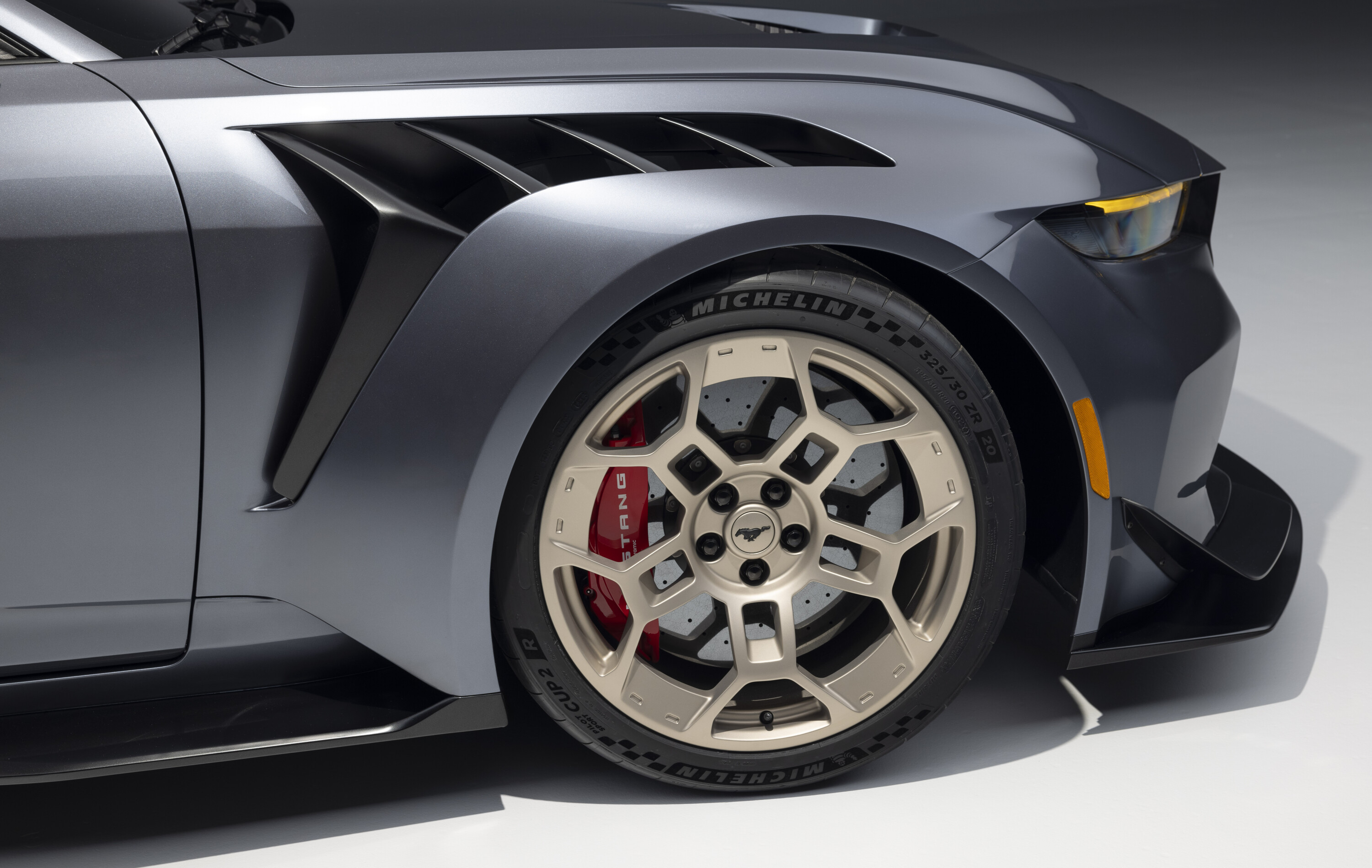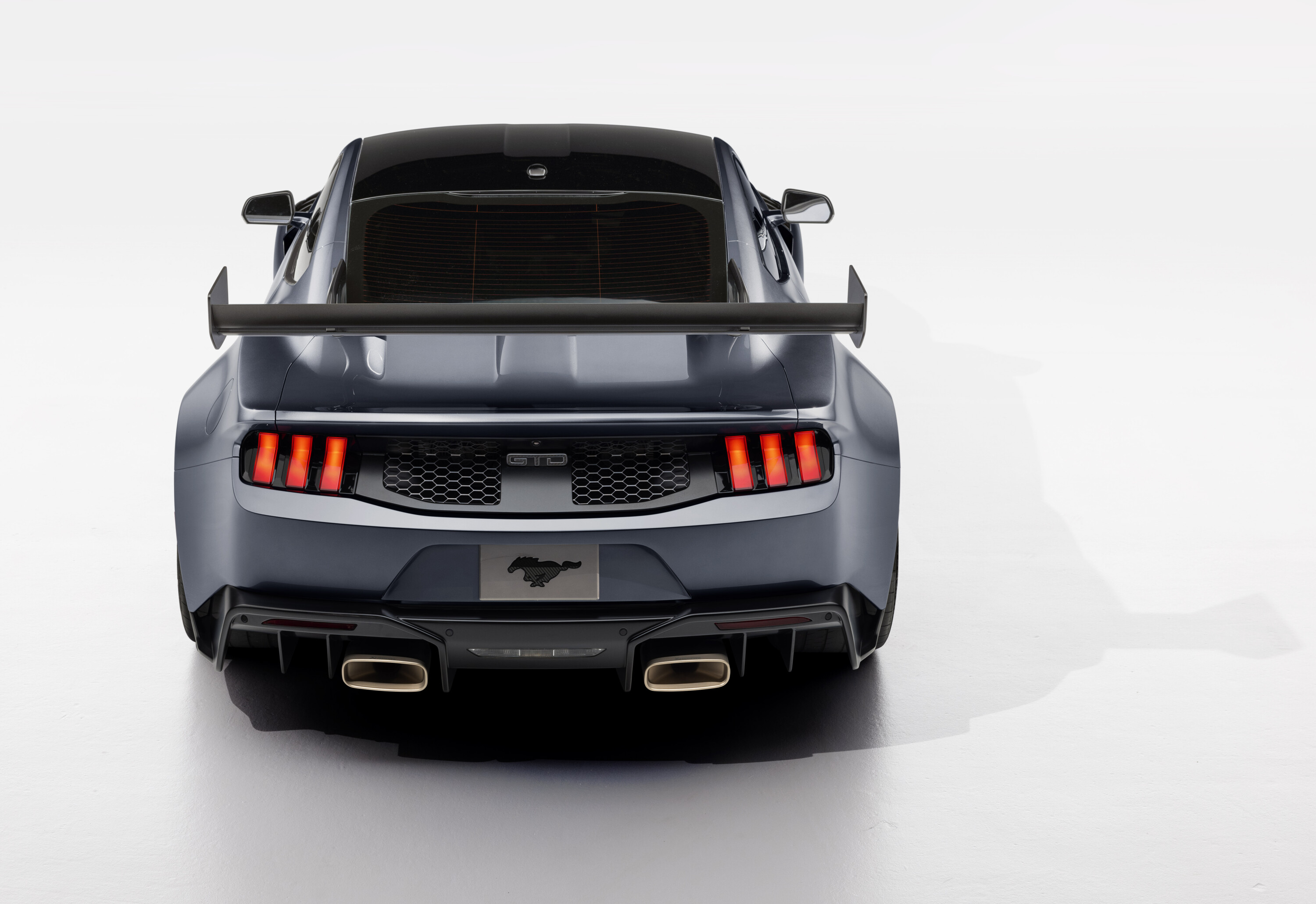
The Mustang GTD makes the Dark Horse R look like child’s play. Ford’s new Mustang variant is, quite literally, a GT3 racer for the road.
Snapshot
- Ultra-limited Mustang racecar for the road revealed
- 5.2-litre supercharged V8 to produce 600kW
- Sub 7-minute Nordschleife time being targeted
- The price? At ‘only’ US$300K, it seems like a bit of a bargain
It began as a skunkworks project behind a wind tunnel in Michigan as a handful of Ford engineers worked fervently to make a Mustang to knock Europe’s best sport sports cars off their Nurburgring Nordschliefe perches. This time, instead of a ground-up supercar, it’s the ultimate Mustang.
Although there’s no word on how many just yet, the GTD will be made in ‘ultra-limited’ numbers with an indicated price of US$300,000 (AU$467,000).

“Mustang GTD represents the very best of Ford Motor Company and what our team needs to do every day,” said CEO Jim Farley.
“This is what happens when we take what we’re good at and push the boundaries to see where the bubble stops. It represents the essence of the transformation we’re going through at Ford, from software to special edition cars,” Farley added.
There’s a clear focus on Ford beating iconic names like the Ferrari 296 GTB, Lamborghini Huracan STO, and – obviously – the Porsche 911 GT3 RS at their own games.
But how’s Ford plan to do it with the humble Mustang?

What is the Mustang GTD?
The Mustang GTD starts life as an S650 coupe, before getting shipped to Multimatic’s Canadian HQ (those behind the GT3 racecar) for a makeover.
That includes dropping a dry-sumped 5.2-litre supercharged V8 that revs to 7500rpm under the bonnet (it isn’t mid-engined after all!) which sends drive to the rear wheels via a carbon fibre driveshaft to an eight-speed dual-clutch transaxle. Outputs aren’t finalised yet, though Ford is targeting 600kW (or 800hp in old money).
An extensive aerodynamic treatment is next. The sculpted front bumper with its jutting splitter channels air exactly where it needs to be. Bonnet vents relieve engine heat, and side scoops cool the semi-active hydraulic suspension and rear transaxle. Carbon fibre is employed for most of the bodywork.

The diffuser is fed by a flat carbon fibre underfloor, and since the GTD is freed from FIA GT3 regulations it’s able to use an active rear wing and front flaps to balance low drag at high speeds, and high downforce in corners.
“Our design team worked in conjunction with the Mustang GT3 design team and the aero team, sharing solutions between race car and road car, and vice versa,” said Anthony Colard, Ford Performance design manager, adding the GTD is “an aerodynamics-driven design”.
Another illegal feature (for GT3 racing) is the Mustang’s semi-active suspension. Driven by hydraulically-actuated twin-rate and height steel springs, the GTD has two suspension settings. Road is the standard setting, and Track mode drops the GTD by nearly 40mm compared to the regular GT.

The short-long double-wishbone front suspension differs from the cooking ‘Stang’s front struts, but not quite as much as the GT3-inspired pushrod multi-link rear suspension with inboard ‘Adaptive Spool Valve’ dampers and a 1:1 leverage ratio.
Grip is taken care of by 325mm wide front and 345mm wide rear semi-slick tyres mounted on 20-inch forged alloys, with lighter-again magnesium wheels available. Brembo carbon ceramic brakes sit behind those attractive wheels.
Just like GT3 cars, the customisable onboard computer has a huge number of parameters for traction controls, giving drivers the ability to tweak exactly how much slip they want. Unlike the GT3 racer, however, the GTD has an interior touchscreen borrowed from the S650 ‘Stang.

The goal? Ford’s chasing a sub-seven-minute Nurburgring Nordschleife lap time. That’s pretty vague, but it’s safe to assume the GTD is benchmarked to beat Porsche and Manthey Racing’s 6-minute 38.8-second lap set by a 911 GT2 RS in 2021.
And, for those wondering, the GTD name has nothing to do with a diesel Volkswagen – it speaks to the ‘GT Daytona’ IMSA racing class made of GT3 race cars.
The marketing exercise? To beat the Europeans at their own game, and from the list of modifications done to the GTD, Ford’s serious about it.

Availability and pricing
Ford hasn’t put a figure on how many GTDs it will sell, the number will likely come down to customer demand and Multimatic’s output capacity. The two factors will make for an ‘ultra-limited’ production.
It’s almost sad how affordable – in relative terms – the GTD will be. Ford’s posted an indicative list price of US$300K, about $470,000 Aussie dollars. That’s only a whisker more than a McLaren Artura and less than a Ferrari 296 GTB. With that money invested in a Mustang GTD, you’re buying into a much more capable track car.
Slated for first deliveries in late 2024 or early 2025, the GTD will start life at Ford’s Flat Rock plant before getting shipped to Multimatic’s HQ in Canada to undergo its hand-crafted transformation into a supercar.
An Australian release is, disappointingly, not on the cards.

Our original story, below, continues unchanged.
August 17: Mustang GTD leaked ahead of reveal
Ahead of an official reveal at Monterey Car Week, pictures of a very racy-looking Ford Mustang have surfaced. They may well be fake, or misleading, so we’ll treat them with a grain of salt.
Rumours from Ford Authority [↗] previously predicted a ‘mid-engined’ road-going Mustang like the C8 Corvette, but if the leaked images are real, they mostly put paid to those thoughts.
Until the racey Mustang’s Monterey unveil, though, we’ll have some fun speculating about Ford’s ‘GTD’ creation that goes above and beyond the S650 Dark Horse and track-focused Dark Horse R.
The GTD name comes from IMSA racing categories, it stands for GT Daytona and, according to the race series the cars “are enhanced (not defined by) technology and utilise the global FIA GT3 specification.”

Unless Ford has fitted an ultra-compact three-cylinder, the proportions indicate the engine’s still ahead of the windscreen. Instead, it’s more likely that there was some miscommunication around what kind of mid-engine layout this is – a front mid-engine one rather than a true midship like a Ferrari 296.
It’s not uncommon for GT3 and GTE racers to move their engines as close to the car’s firewall as possible and therefore behind the front axle – hence the mid-engined terminology. Porsche notably made this move (albeit in reverse) with its latest 992 911 GT3 racer, the first 911 in history to adopt a true mid-engined layout.
The YouTube video Facebook post that leaked the GTD is grainy and the images are warped, though we can still see it appears to be wearing Michelin treaded track tyres wrapped around deeply dished five split-spoke rims.
At the rear is a version of the Mustang GT3 racecar’s incredible swan neck rear wing and there are dramatic bonnet and front fender vents to let heat out of – presumably – the Coyote V8 and front brakes. It has indicators and headlights just like a road car.
The only feature we’re a little miffed about is the open vent that sits just rear of the door – what is it for? They could be to cool the supposed mid-mounted V8, or perhaps a rear electric motor.
More likely, given their size and shape, these vents (that we also see on the GT3 racer) are for either feeding aerodynamics, or cooling the differential and rear brakes.
According to Ford Authority, this roadgoing supercar is to be produced by Multimatic, Ford’s racecar producer of choice for the Ford GT3, and existing Mustang GT3 and GT4 racers.
If this is more than just a concept car, then we’re in for a treat with Ford’s latest S650 Mustang range. More to come as Monterey Car Week rolls on.
We recommend
-
 Features
FeaturesGT3 racer vs road car: what’s the difference?
How much is different on the GT3 racers that are tackling Bathurst, compared to their road-going brothers
-
 Reviews
Reviews2024 Ford Mustang Dark Horse review: First international drive
We saddle up in the raciest version of Ford's seventh-generation pony car to discover a sports coupe that entertains the driver beyond its V8 engine
-
 News
NewsFord Mustang Dark Horse R: $215,000 track car revealed
Turn-key track car based on new-generation Mustang coupe and forms basis for new one-make racing series.




